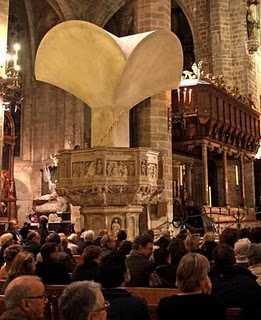|
|||||||||||||||||||||||
|
|||||||||||||||||||||||
GAUDÍ’S SOUNDBOARD (AMPLIFIER), PERFECTLY EXPENDABLE |
|

Antoni Gaudí led the restoration of the Cathedral of Mallorca between 1903 and 1914 at the behest of Bishop Pere Joan Campins. The Catalan architect got many things right, made a few mistakes and left us works of art that can only be understood if placed within the context of the progress of that era. The removal of the choir from the centre of the cathedral increased the gothic nature of the temple, brought the faithful closer to worship and recovered the immense cathedral space. The removal of the baroque altarpiece emphasized the presbytery and re-established the view of the Trinitat Chapel. The stained-glass windows he designed are, by far, the best. The baldachin solved the illumination problem and centres attention on the nucleus of the religious celebration. In its time it also acted as voice-projector of the celebrant thanks to the tapestry on its upper section. Nowadays nobody would accept some of Gaudí’s decisions in relation to illumination. Such as for example the “trobigueres”, lamps of wrought iron which embrace the columns of the central nave limiting its slenderness. Or the presbytery lights, which seem more appropriate to a “verbena” (night festival) than the sobriety of a cathedral. Gaudí designed various soundboards atop each of the pulpits which formed part of the old choir and which were moved to either side of the presbytery. The cathedral, with the expert work of the intelligent architect Elies Torres, has recovered the one that the Catalan architect placed upon the major pulpit, to the side of the Evangelio. It was executed with ephemeral materials – wood and cloth – and removed in 1972, when the sound amplification techniques made its function expendable. The Mallorcans ironically christened it the “esclata-sang” (mushroom). It was playing with fire. In other words, if it doesn’t work, remove it and transfer it to a museum as one more element for the study of Gaudinian art. If I may be permitted to express an opinion, we are talking about a perfectly expendable element. The monumental octagonal pulpit of Juan de Salas from Aragón – sculpted between 1529 and 1531 – has more than sufficient merit without Gaudí’s esclata-sang. | |
|
|